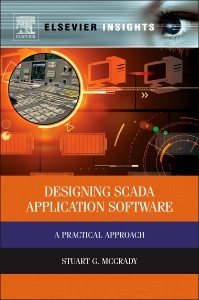Description
Designing SCADA Application Software
A Practical Approach
Author: McCrady Stuart G
Language: English
Subjects for Designing SCADA Application Software:
246 p. · 15x22.8 cm · Hardback
Description
/li>Contents
/li>Biography
/li>Comment
/li>
Automation systems, often referred to as SCADA systems, involve programming at several levels; these systems include computer type field controllers that monitor and control plant equipment such as conveyor systems, pumps, and user workstations that allow the user to monitor and control the equipment through color graphic displays. All of the components of these systems are integrated through a network, such as Ethernet for fast communications.
This book provides a practical guide to developing the application software for all aspects of the automation system, from the field controllers to the user interface workstations. The focus of the book is to not only provide practical methods for designing and developing the software, but also to develop a complete set of software documentation. Providing tested examples and proceducres, this book will be indespensible to all engineers managing automation systems.
1. Introduction2. The Elements of SCADA Software3. Practical Procedures for SCADA Software Development4. Documentation for SCADA Systems5. Tagnames and Signal Naming Conventions6. Developing the Application Program Databases7. Process Control Logic Descriptions8. User Operations Reference Manual9. Guidelines for Controller Application Programming10. Guidelines for Workstation Application Programming11. System Integration, Commissioning, and Checkout12. Sample Project – Applying the Principles
Appendix A GlossaryAppendix B TSNC DictionariesAppendix C Sample Process Control Logic DescriptionAppendix D Complete Listings for Sample Program
Stuart McCrady is a Certified Engineering Technologist in the field of Electronics and Physics Engineering, as well as a Certified Professional Educator in the field of technical training for adults. He spent the first two years of his career in electronics, installing and servicing both large mainframe computer systems and small minicomputers. He then shifted to software programming in automation systems. This field of minicomputer programming required developing application software in machine or assembly language, executing at the hardware level. Field devices such as limit switches, pushbuttons, and solenoid valves, were connected to custom designed hardware interface boards installed inside the minicomputers. From the minicomputers of the 1970s to the PLCs and HMIs of today, Stuart has worked with a broad range of technologies using a variety of hardware and software platforms. He was involved in the design and implementation of more than 50 SCADA type projects. As his career progressed, Stuart acquired both more experience and more responsibility in the field of system integration and SCADA systems consulting. Stuart has served as programmer, project leader, project administrator, consultant, department manager, and SCADA system designer.
Throughout his career, Stuart strove to establish programming standards and design methodologies that could be applied to any SCADA application. In the mid-1970s, he developed a program design and documentation system which he called FLOCODE, which resembled high level languages such as C, but was written in plain English. The purpose of the system was to allow the programmer to design software using English-like statements using structured programming constructs such as: If-Then-Else and Do-While/Do_Until. He applied this method to his own programming at both the high level language and the machine level language; this design documentation then became the comments and program description once the program was comple
- Clear instructions with real-world examples
- Guidance on how to design and develop well-structured application programs
- Identification of software documentation requirements and organization of point names with logical naming system
- Guidance on best practice of standardized programming methods for SCADA systems

